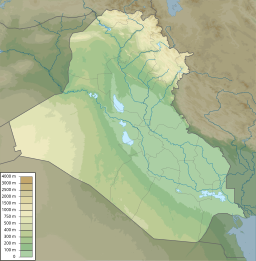Lake Hamrin is a human-made lake approximately 50 km (31 mi) north-east of Baqubah, in Iraq's Diyala Governorate. The town of Hamrin sits on the western shore of the lake, both of which are at the southern tip of the Hamrin mountains. The Hemrin Dam, which creates Lake Hamrin, was established in 1981 as an artificial dam to hold over two billion cubic metres of water. It is a source of fish and also provides water for nearby date palm orchards and other farms. In June 2008, it was reported that due to Iranian damming of the Alwand River, the lake had lost nearly 80% of its capacity.[1]
| Lake Hamrin | |
|---|---|
| Location | Diyala Governorate |
| Coordinates | 34°11′28″N 44°59′42″E / 34.19111°N 44.99500°E |
| Type | Reservoir |
| Basin countries | Iraq |
| Surface area | 340 km2 (130 sq mi) |
| Water volume | 2×109 m3 (1.6×106 acre⋅ft) |
| Settlements | Hamrin |
Archaeological excavations
editIn the late 1970s, prior to the flooding of the lake, several archaeological sites in the flood plain were excavated. Excavations were led by various international organisations, such as the British Archaeological Expedition, as well as the Iraqi State Organisation for Antiquities and Heritage. Sites excavated include the Ubaid period sites of Tell Abada, Tell Madhur, Tell Saadiya, Tell Rubeidheh, Tell Rashid and Tell Haizalun.[2][3] The Hamrin sites probably shared a localised form of the Ubaid culture and possibly operated as one administrative unit based out of Tell Abada.[4]
-
Polychrome painted jar, geometric designs and animals, the so-called "Scarlet Ware". From Tell Abu Qasim at Hamrin Basin. 2800-2600 BCE. Iraq Museum
-
Painted pottery jar with geometric motifs and birds. From Tell Hasan at Hamrin Basin. 5th millennium BCE. Iraq Museum
Droughts and Climate Change
editReferences
edit- ^ "The New Humanitarian | Disappearing lake a blow to livelihoods".
- ^ Roaf, M. 1982. "The Hamrin Sites." In: J. Curtis (ed.) Fifty Years of Mesopotamian Discovery. London: The British School of Archaeology in Iraq, pp 40–47
- ^ R. G. Killick, "Excavations at Tell Rubeidheh: An Uruk Village in the Jebel Hamrin", Iraq Archaeological Reports, 2, British School of Archaeology in Iraq and Directorate of Antiquities, Baghdad; Hamrin Salvage Report, no. 7, Warminster: Aris & Phillips, 1988
- ^ Jasim, S. 1985. "The Ubaid period in Iraq. Recent excavations in the Hamrin region." British Archaeological Reports International Series: 267
